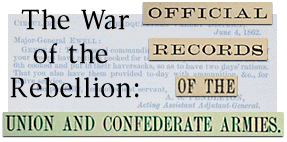Summary:
Union General Gustave Cluseret reports to Jacob Cox concerning November, 1862,
plans for action in the Shenandoah Valley. Cluseret proposes forcing Thomas J.
Jackson to move by threatening the important rail and supply center of Staunton,
VA.
Maj. Gen. JACOB D. COX:
NEW CREEK,
November 19, 1862.
Received at Charleston, W. Va., November
20.
GEN.:
I do not think there is the least use of our remaining at New Creek. As we told Gen. Kelley, his fears were entirely without foundation. What interest can Jackson possibly have to destroy more of the railroad than he has done, when we reflect on the risk and possible consequences that may arise to him from pushing up into the north-west? The object of destroying a railroad is not so much to capture property as to destroy communication. The latter object Jackson has already attained; further destruction would not advance that object; it would be a piece of folly or deliberate malice, of neither of which Jackson is ever guilty. His position and the disposition of his forces clearly indicate a very different object. Posted on the right flank, and in the rear of the army of Burnside, behind passes by which he can debouch at will to a point between that army and the capital, he is in no standing danger, and can be dislodged from his position only by a battle or by a strategic movement. It is absolutely impossible that he should forego the advantages of such a position to move upon a foolish expedition, which no military man would ever conceive of. What use are we? He, then, absolutely knows that Jackson ought to be dislodged. There are naturally two means of doing this: One by attacking him, which will not probably be done, but which, had I the power, should by all means be done, by a corps detached on the east from Burnside's army and a combination of the troops of Harper's Ferry, Hagerstown, Cumberland, and New Creek from the west, got together in all speed, and by means of the railroad. The other means is by a strategic movement, which I shall point out. Threaten at once Staunton and the railroad of the south. Jackson will then do one of two things-either he will march through the valley to relieve the threatened point, and rejoin the Southern army, in which case he will leave Winchester and the Baltimore and Ohio Railroad open, or he will remain where he is, and we can the destroy a line of communication and a depot of supplies much more important than the dangers occasioned by his position at Winchester.
Now, Staunton and the railroad can be threatened as follows: First, by reuniting our whole force at Beverly; second, from that point to march upon Warm Springs and fall upon the troops there, or, according to circumstances, pass over to the east of that place and fall suddenly upon Staunton, and destroy the railroad bridges between that place and Charlottesville; but this is a plan that only can be matured on the spot; third, a strong detachment of troops, under Gen. Cox, should make a demonstration against Lewisburg, threatening the railroad of the south.
In all probability, if the demonstration is well made, the rebels at Warm Springs will unite with those at Lewisburg, and we can profit rapidly of that movement by falling upon Staunton. If, on the contrary, the troops at Lewisburg are left to themselves, we can each move separately, as we are much stronger, and thus open a double way to Staunton and the railroad to the south. For the execution of this plan we need 1,000 cavalry, or a full regiment, which must be had, if only temporarily.
Respectfully,
G. P. CLUSERET,
Brig.-Gen.
Bibliographic Information : Letter Reproduced from The War of The Rebellion: Official Records of the Union and Confederate Armies, Series 1, Volume 21, Serial No. 31, Pages 779-780, Broadfoot Publishing Company, Wilmington, NC, 1997.

